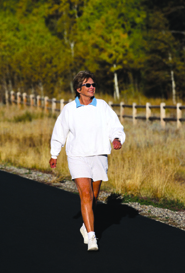Exercise and sports
A regular exercise program can help you to enjoy your body and to avoid tiredness caused by a sedentary lifestyle. It is important to choose physical activity that is appropriate for your age, sex and overall physical fitness, keeping in mind any illnesses or ailments.

+ Not all physical exercises are the same, some may be better for a particular age group or for your overall fitness. It is recommended to consult your doctor before starting an exercise program to help you choose an activity which avoids overstraining or getting disappointed with your physical level. Studies have shown that regular exercise significantly increases life expectancy and improves overall health. An improved self-image and increased energy level are frequent added benefits of exercise.
Keeping your body in good working condition for daily life and health isn't about running marathons; it's about maintaining a healthy level of physical activity. You can start to exercise at any age, the young and old should incorporate regular physical activity into their everyday lives. Gradually building up the time spent doing the activity by adding a few minutes every few days, when your body feels stronger, faster and more flexible.
Choosing a fitness program can include a variety of physical activities, from going to a gym, to playing a sport or walking daily. Aerobic activity is good for improving cardiovascular health, losing weight, toning the muscles and increasing your energy level. Aerobic activity is ideal for people who are recuperating from an ailment, who haven't exercised in a while, or for people who are over 50 years of age.
Competitive sports, have the same benefits as aerobic activity, but require time-commitment, a high-level of physical fitness and appropriate training to avoid injuries or other physical risks. It is recommended to begin an exercise program under the supervision of a physical trainer, and only after having a complete physical checkup.

EXERCISING ACCORDING TO YOUR AGE
∎ Between 18 and 35 years old
This is one of the best stages in your life to practice sports, because your physical fitness is at its peak. It's ideal to practice sports during childhood because the benefits from physical activity later on in life will be greater. It's recommended to carry out a regular physical fitness routine so that your body stays toned and fit, increasing your stamina so that you don't get tired out as easily. If you exercise or train daily, it's advised to take a break at least one day a week, or to alternate between light exercise and intense physical training, so that your body doesn't get fatigued.
∎ Between 35 and 50 years old
If you are in good health, you can do any physical exercise or competitive sport, using precaution. Stamina, flexibility and strength begin to decrease during this age period, increasing the risk of injury and fatigue. It's best to work out at a moderate rate, three days a week. It's also recommended to practice activities that are beneficial for the health but low risk for injuries such as swimming, walking and biking. For those who have practiced sports or worked out regularly throughout life, you can train four to six days per week at a medium-high intensity. It's best to incorporate exercises that increase and support the body's stamina and flexibility, like running for 30 minutes or biking for an hour.
DAILY EXERCISE
Many adults don't realize the amount of exercise that the body needs to stay healthy. It's important to keep in mind the benefits to help continue a regular exercise routine and avoid adapting to a sedentary lifestyle. However, in order to stay healthy, it is not necessary to exhaust your body doing rigorous exercises. Walking for half an hour or swimming 15 minutes a day is enough to keep our bodies healthy. Other day-to-day tasks such as washing the car, walking up stairs, going for a stroll (with a friend) and cleaning the house are all daily physical activities that keep up our physical stamina.
∎ Between 50 and 60 years old
Our bodies begin to change: we lose muscle mass, increase fat on the muscles and our capability to recuperate from tired muscles decreases. For this age group it is fundamental to keep active to stay as fit as possible.

Although it would be ideal to practice a competitive sport at this age, it is best advised to go to the gym or to go walking. If up to this age you haven't regularly exercised, it's best to start with a low-impact physical activity and to build up your resistance so that you get less tired. It is recommended to begin sports such as golf, swimming, walking or biking, always after consulting your physician. Symmetric sports are best, that's to say exercises that work out the left side of your muscle mass and the right side too, so that your entire body is equally strong. For those who have played sports or worked out throughout most of their lives, it's best to continue with the favorite sport, okayed by your doctor. However, alternate the sport with some type of gym work out that increases your flexibility like yoga, stretching or pilates.

SAFETY
If you take a break from playing sports or working out because the body feels fatigued and after a period of rest you don't feel better, it is important to visit your doctor for a checkup. This prolonged tiredness can be a symptom of an illness or injury that can worsen by continued exercises or athletic training.
∎ Over 60 years old
Continued and controlled exercise increases the organs’ resistance to aging and lowers muscular and cardiovascular deterioration. For those of us in this age group, an exercise routine can help to avoid a sedentary lifestyle and many illnesses.
Recommended sports for this age group include swimming, aqua aerobics and walking.
ATHLETE'S FATIGUE
Among athletes, muscular and joint pains are frequent and common. Many times we ignore these pains until they begin to impede our normal daily activities.
Sports injuries caused by fatigued muscles or joints are the most common among athletes. They can be prevented by stretching, warming up and correct training under a trainer's supervision. Loss of appetite, insomnia, irritability, decreased ability to recuperate and muscular or joint pains and cramps are symptoms of fatigue or over-training. In general, reducing intense physical exercise can reverse this situation to be able to return to normal physical activities.
